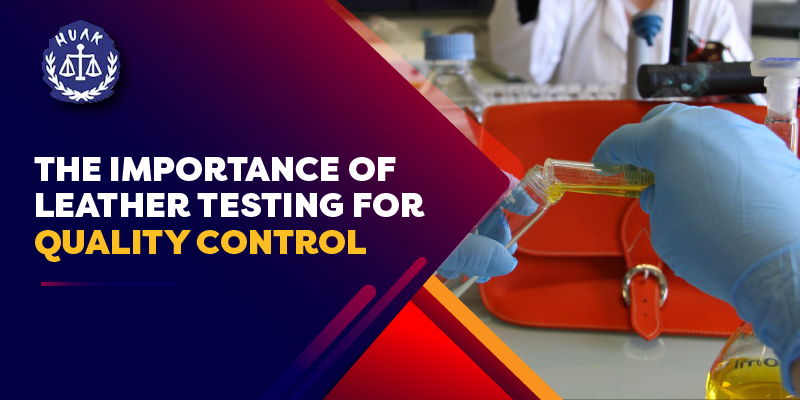
Leather is a material that is used in many industries, including furniture, automotive, aviation, fashion, and more. However, the type of animal hide, tanning method, and production procedures affect the product’s quality and longevity; thus, leather product testing is crucial to guarantee that the products meet industry standards and customer expectations.
What Is Leather Testing?
Leather testing involves analyzing the material’s physical and chemical properties to determine its performance and quality. The products can be tested for strength, durability, colorfastness, wear resistance, and more using chemical, physical, and migration analysis methods. Some of the problems that can be found and fixed by evaluating your leather goods before they are sold are:
- Leather’s flexibility and condition
- Signs of fast growth
- Color Disparity
- Coatings and leather cracking
- Variation in color
- Weak leather
- Issues With Finishes
- Smell
- Colour shift
- Breakage
Testing Leather For Conformity With Standards
ISO conducts the following tests to decide whether leather goods are suitable for sale according to international standards and laws.
- ISO 2589:2016 for Thickness Determination: This applies to the entire piece of leather and a small sample, regardless of the tannage.
- Surface Coating Thickness Determination – ISO 17186:2011: Taking the thickness of the surface layer off of various kinds of leather while they are not compressed.
- Establishing Firmness—ISO 17235:2015: A non-destructive test is available for soft leathers, such as shoe uppers, upholstery, and garment leather.
- A Standard for Density Measurement—BS EN ISO 2420:2017: Generalizes to all leathers to find their density and mass/area.
- Testing for Flex Resistance in Compliance with ISO 5402-2:2015: This method can find the dry and wet flex resistance of leather and finishes with a thickness of less than 4.0 mm.
- 105-E07:2010 for water staining and ISO 15700:1999 for water fastness: Assess how well a final product or sample withstands water.
- Wet and Dry Adhesion Testing for Leather Finishes – ISO 11644:2009: Analyze the bonding capabilities of different leather and synthetic substitute finishes.
- Specifications for Testing the Tear Strength of Leather—ISO 3376:2011, ISO 3377-1:2011, ISO 3377-2: 2016: Multiple methods for measuring tear load and tensile strength.
- 105-B02:2014 and ISO 15701: 2015 for Light and Color Fastness: Find out how well the color will hold up against fading, bleeding, dye or pigment running, and migration.
- Testing for Rub Fastness – ISO 17700:2005: Determines how well leather retains its color after repeated rubbing.
- Leather Finish Cold Crack Testing – ISO 17233:2017: Test the environmental cracking resistance of leather coverings.
Quality Control Process
There are many important stages in the complex process of quality control in leather production:
- Inspection of Raw Materials:
Raw animal hides are carefully examined. This stage identifies and fixes any flaws, ensuring that only high-quality hides are used in manufacture.
- Controlling Tan and Dye:
Accuracy in tanning and dyeing is crucial. Defects at this level are difficult to fix and frequently require starting over.
- Physical Test:
This process evaluates leather tensile strength, elasticity, and thickness.
- Visual Inspection:
The leather is carefully examined to find flaws. This includes checking for scars, flaws, and discolorations that could affect the final product.
- Chemical Testing:
Confirming that leather meets international chemical safety requirements is the final quality check. This makes the leather safe to use.
Leather Test: Why Are They Necessary for Quality Assurance?
- Quality Control
When it comes to quality control, nothing is more important than leather testing to ensure that items are up to standard. Testing potential quality issues before launching products allows manufacturers to identify defects, helping them avoid recall costs and reputational damage.
- Durability
Testing is required to guarantee that the leather goods are aesthetically pleasing and sturdy enough to last. Customers expect the leather items they purchase to be durable, making the purchase worth it. Quality control fulfills these expectations.
- Determine Tanning And Production Method
Testing the material can help determine the best tanning and production methods for leather goods. This makes it easy for manufacturers to get the ideal softness, color saturation, and durability in a certain leather product.
- Identify Safety Risks
One of the many dangers that leather testing might reveal is the presence of heavy metals, which can harm both people and the environment. An essential part of testing leather is migration analysis, which looks for signs of possible transfer of toxic compounds from the leather onto other surfaces, such as skin.
- Verify Authenticity
Testing is one way to verify the authenticity of leather goods and get them the genuine leather label.
- Consistency
As part of quality control, all leather goods must be consistent in tone, grain, and sheen. This consistency is crucial for a brand’s reputation and for keeping customers loyal, and testing guarantees it.
Conclusion
Leather product testing plays a huge role in ensuring high-quality leather products. In addition to preserving the credibility of brands around the world, it ensures that only safe, high-quality items are manufactured and sold to customers. Zhejiang HUAK Testing Technology Co. Ltd. offers full-service leather testing to guarantee that all clients’ products have passed rigorous quality and safety inspections. Contact us to have your products certified!

Leave a Reply